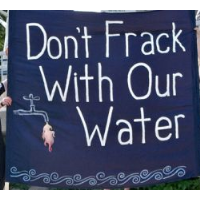State Moves Slowly on Oil Extraction Rules Favored by the Feds
 (photo: Toban Black, Flickr)
(photo: Toban Black, Flickr)
When state regulators responded to criticism last year from the U.S. Environmental Protection Agency (EPA) about lax enforcement of oil and gas drilling regulations, they tightened up rules on injection wells that included a controversial practice called hydraulic fracturing, or fracking.
Governor Jerry Brown responded to the regulators by firing them and returning to the status quo.
Derek Chernow, acting director at the state Department of Conservation, and Elena Miller, head of the Division of Gas, Oil, and Geothermal Resources (DOGGR), were both let go after the oil industry complained that the new rules cost them money and unnecessarily slowed them down.
Environmentalists were in an uproar, but could do little except wait for Sacramento’s official response to the EPA report that said the state was not adequately protecting potential drinking water. Sixteen months later, the state report was released, and its deliberative recommendations were warmly received—by the oil industry.
“We are always willing to look at sensible new regulations when they are needed,” Rock Zierman, CEO of the California Independent Petroleum Association, wrote in an email to the Bakersfield Californian.
Right now, there aren’t many regulations, sensible or otherwise, governing the use of fracking, a technique that entails injecting millions of gallons of pressurized water, chemicals (some toxic), sand and other substances into a well to crack open the rocks and allow easier access to oil and natural gas.
Drillers are not required to tell the state where they are fracking or what chemicals they are injecting into the ground, claiming trade secrets are involved. Critics say hydraulic fracturing has been linked to groundwater contamination, air pollution, releases of methane gas, micro-earthquakes and sink holes. Fracking is particularly useful in reaching oil and gas deposits in wells once considered depleted using conventional techniques, and in shale formations thought to beyond reach. Both are plentiful in California.
The new report by DOGGR called for additional staffing, more training and annual reviews of underground injection programs. The division vowed to pursue legislation and draft rules that would strengthen oversight.
Tim Krustic, replacement for the fired Elena Miller, wrote that his division was doing great and was going to do even better. “Although the Division has a strong regulatory program, the Division is pursuing greater and more consistent enforcement.”
Two bills were rejected by lawmakers in the last session that would have stopped fracking until oversight was beefed up or required more information about where and when fracking was taking place.
–Ken Broder
To Learn More:
In Response to Federal Audit, Oil Regulators Vow New Rules (by Michael J. Mishak, Los Angeles Times)
Oil Czars Say California's Rules Are Outdated (by John Cox, Bakersfield Californian)
Response to the US EPA June 2011 Review of California’s UIC Program (Division of Oil, Gas and Geothermal Resources) (pdf)
California Class II Underground Injection Control Program Review (by James D. Walker, Horsley Witten Group, Inc.) (pdf)
Oil Worker's Death Renews Debate on Safety of Extraction Method (by Michael J. Mishak, Los Angeles Times)
Brown Ordered Firing of Regulator Who Took Hard Line on Oil Firms (by Michael J. Mishak, Los Angeles Times)
Two Bills to Regulate Fracking Die in the Legislature (by Ken Broder, AllGov California)
- Top Stories
- Controversies
- Where is the Money Going?
- California and the Nation
- Appointments and Resignations
- Unusual News
- Latest News
- California Forbids U.S. Immigration Agents from Pretending to be Police
- California Lawmakers Urged to Strip “Self-Dealing” Tax Board of Its Duties
- Big Oil’s Grip on California
- Santa Cruz Police See Homeland Security Betrayal in Use of Gang Roundup as Cover for Immigration Raid
- Oil Companies Face Deadline to Stop Polluting California Groundwater





